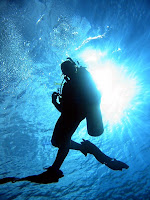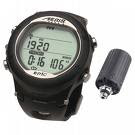By Nick Stanlow
It can be hard to enjoy scuba diving if you can’t see anything well enough, and it can also be dangerous. This includes when the mask fogs up or too much water gets into the mask.
Knowing about the methods of scuba mask clearing is essential for these reasons. By using the right scuba mask clearing techniques you will have a more enjoyable and safer scuba diving experience.
First of all you should understand how your scuba mask can become fogged up or retain water. During the scuba diving experience you can start sweating while underwater. The sweat droplets can come from the forehead and then condense onto the inside of the scuba mask.
Also, breathing warm air through the nose can cause the mask to become foggy. Also, when warm air hits the plate when it is cold the screen will become foggy due to the condensation of the warm air.
You’ll need to use good preventive care for scuba mask clearing. First, you should clean the inside of the mask and seal it with some material that can help dry up any sweat drops as they begin to form. For example, you can use anti-fogging spray to help prevent fogging from happening. There are several other methods that have been created by other divers over the years as well, and you can find more information about this online.
Another way of scuba mask clearing involves using shampoo. By rubbing some shampoo onto your fingers and spreading it around the inside of the mask and then rinsing it off you can help the mask to absorb any water molecules that may cause fogging. It is important that you use a tearless type of shampoo so that your eyes will not be irritated if you use this method of scuba mask clearing.
Sometimes when scuba diving water may seep into the inside of the mask through the skirt edge of the mask. Usually this involves a small amount of water, but it can grow over time if not taken care of. When you do see water get into the mask take a deep inhale through your mouth and breathe through your nose.
Also, at the same time you do exhale you should tilt the bottom part of the scuba mask. However, you will have to be sure that you exhale and tilt at the exact same time or else more water will come in. Try practicing this above water before trying it out for real. If the mask begins to fog during this scuba mask clearing process it should not be a problem, as that fog will disappear in a few seconds.
By knowing the right scuba mask clearing methods you will have a better scuba diving experience. Be sure to follow the methods exactly so that no additional water will be let into the mask. Also, by using preparation methods like rubbing shampoo around the mask and cleaning it you will be able to reduce the risk of water through condensation or sweating entering the mask.
For More Info, check out http://www.scubadivingfreak.com
Article Source: http://EzineArticles.com/?expert=Nick_Stanlow
Thursday, September 4, 2008
Proper Scuba Mask Clearing
Thursday, August 21, 2008
Scuba Diving is Fun for Everyone
Dive, Dive, Dive! Scuba Diving is Fun for Everyone
By: Stephen Dolan
Everybody knows what scuba diving is; it is the diver with the air tank on his back and a mouthpiece. The basic scuba set-up is a tank of compressed oxygen on the diver's back, with a line to a mouth piece. The oxygen is delivered through a mouth piece, allowing the diver to breath.
Few people actually know that scuba stands for something, however. The word scuba is actually an acronym for Self Contained Underwater Breathing Apparatus.
Scuba diving is, of course, different from unassisted diving. The history of scuba is quite recent. The biggest advance on the path to scuba diving came in the 16th century, when people started using diving bells to pump air from the surface to people underwater.
Needless to say, things have advanced a fair bit since then, although the diving bell remained an important method for centuries. Scuba diving as we know it really came together during and after World War II.
Why is scuba diving such a popular sport?
It is hard to think of a sport or hobby more exciting or rewarding than scuba diving. First off, scuba diving gives you access to underwater life in a way nothing else can.
The vast majority of the world is underwater and waiting to be explored! When you scuba dive, you become one of the few people to have ever ventured into this exotic world to any degree. The world's seas and oceans are some of the last few undiscovered places on our planet - that is why scuba diving is so awesome.
There is also the fact that it can be absolutely beautiful under the water. If you have ever had the opportunity to go scuba diving off the coast of Australia along the Great Barrier Reef, you will know how amazingly gorgeous life under the sea can be. Scuba diving can even give you the chance to search for buried gold and treasure.
From the Caribbean to the Mediterranean to the Great Lakes to the English Channel, there are countless shipwrecks waiting to be explored.
Risks associated with scuba diving
It should be noted that, despite being an amazing hobby or sport, scuba diving can be dangerous; after all, you are putting yourself under water and hooking your lungs up to a tube of air. If something goes wrong with your air or you become trapped, then you will experience obvious difficulties.
The most common injury related to scuba diving is a result of changes in air pressure. As you go deeper underwater, the pressure around you increases. If the pressure becomes too much, you can rupture your eardrums or damage your sinuses. And if you come up from underwater too quickly, you can also get the bends, also known as decompression sickness.
How to become a scuba diver
Before getting into the water, it is important that you receive the proper certification from your national certification board to be a scuba diver. Indeed, many rental agencies will not rent you equipment without proof of certification. Across the world PADI is the best recognized certiication.
Article Source: http://www.articleblender.com
Steve Dolan is a PADI certified scuba diver who loves to dive all over the world. Find out how to join in at Scuba Diving and Snorkelling. Need a cheap flight to get there? Cheap Tickets and Cheap Travel
Don't Go In The Water Without A Quality Dive Watch
Don't Go In The Water Without Being Equipped With A Quality Dive Watch
By: Gregg Hall
i am bookwise
Beneath the ocean or seawater lies a whole new world. Brilliantly colored fishes, plants, and additional creatures can bring divers to a new realm. With this in mind, it is easy to forget that it is imperative to check gauges, depths, and directions regularly. Here is where scuba diving watches become all important tools.
It is easy to forget time while underwater. This can be troublesome as your oxygen is limited, usually to an hour or two tops. One of the greatest inventions has to be scuba diving watches. These handy devices can help keep you informed to your surroundings, depths, and many come with an alarm that cannot be missed. Scuba diving watches often come with temperature gauges, depth readings, compasses, timers, ascent rate alarms, calendars, decompression alarms, and more. Each of these functions can help an active diver avoid the dangers that can escape you while you are gazing at an ocean or sea's beauty.
Citizen, Invicta, Luminox, Seiko, and Suunto happen to hold the top seven positions for best selling diving watches. Their stylish appearance suits each brand name, but the range of functions is what sets them apart as the creme de la creme. These watches are amazing!
Citizen has two contenders in the top seven. The Promaster Aqualand's stainless steel construction makes this a classy choice. The Eco-Drive is the company's titanium offering. Both watches feature storage for diving depths, current water temperature, present depth, ascent rate alarms, and are water resistant to 660 feet.
Invicta's Pro Diver Automatic is another stainless steel option. Waterproof to 660 feet, it is one of the better selections for more adventurous divers. Invicta's Pro Diver requires no batteries, has an anti-scratch watch face, and has luminescent watch hands. The screened markers ensure you will not get lost.
Luminox's Navy Seal Dive Watch is the most popular scuba diving watch brand chosen by the United States Navy. This watch offers many top features including compass, diving depths, date, and time.
Seiko offers the Dive Collection watch. With up to 650 feet of water resistance, glowing hands, stainless steel construction, a depth gauge, and luminescent date display, the Dive Collection watch is a stunning and functional selection.
Suunto also offers two watches. The Mosquito Pro Dive has a resin band, calendar, alarms, and digital displays. This watch only offers a little over 325 feet of waterproof protection, however, so it may not be suitable for deeper dives. The D6 are computerized scuba diving watches that offer excellent storage for diving records, decompression rates, and a built in compass keeps you from getting lost.
Ultimately, the watch you select should be one that fits your needs. Compare features on scuba diving watches to ensure you select a watch that meets or exceeds your qualifications.
Article Source: http://www.articleblender.com
Gregg Hall is an author living in Navarre Beach, Florida. Find more about this as well as diamond watches at www.only-watches.com
aStore
-
Recent Posts
All Post
- Proper Scuba Mask Clearing
- Scuba Diving Is Fun For Everyone
- Don't Go In The Water Without A Quality Dive Watch
- Online Dive Classes: A Safe Way To Start
- The Breast Implant Scuba Diving Connection
- Scuba Diving In Texas
- The Importance Of The Steel Scuba Diving Tank
- Suunto Gekko Scuba Diving Computer
- Dive Computers: Types And Styles
- Scuba Diving In Amergris Caye, Belize
- Aruba Scuba Diving - King Of The Wrecks
- Scuba Diving Rules For A Safe Dive
- Scuba Diving With Club Med In Turks
- Deap Sea Diving
- Features Of A Dry Suit
- Prior To Scuba Diving
- Dive Computers: Types And Styles
- Scuba Diving Certification
- Scuba Diving Masks Tips
- All Inclusive Scuba Diving Vacations
- Dangers Of Scuba Diving
- Scuba Diving in The Bahamas
- Back To Scuba Diving Basics
- Calgary Scuba Diving
- 3 Steps Free Dive Training Program
- Dive Sites At Sipadan Island
- Choosing a Different Destiny
Sports and Recreation
Health and Fitness
Recent Comments
Caribbean
- The Best Place To Shop In The Caribbean
- Caribbean Island Of St Thomas
- Hide Out In A Caribbean Vacation Rental
- Tips For Travelling To The Caribbean
- Caribbean Is The Perfect Honeymoon Destination
- A Cruise In Caribbean
- Caribbean Beach Vacations: Top 10 Destinations
- So You Want To Take A Vacation In The Caribbean
- Beating The Winter Blues In Aruba
- Aruba: Paradise For Watersport Enthusiasts
- Diving Arround Amazing Wrecks
- Cheap Holiday Vacation To Aruba
- The Advantage Of Underwater Fishing Cameras
- Underwater Cameras